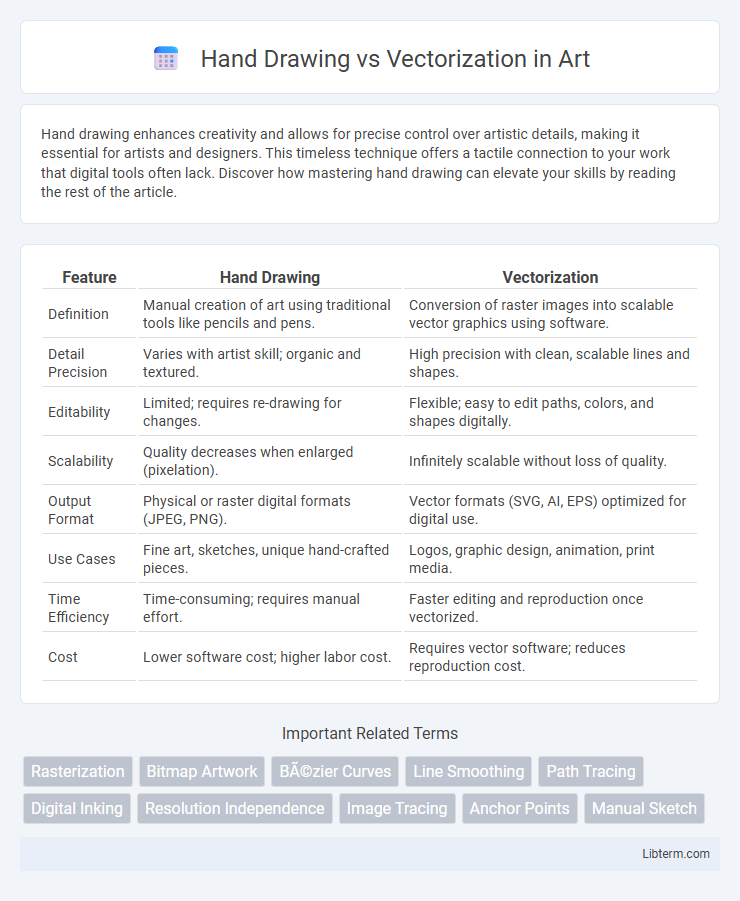Hand drawing enhances creativity and allows for precise control over artistic details, making it essential for artists and designers. This timeless technique offers a tactile connection to your work that digital tools often lack. Discover how mastering hand drawing can elevate your skills by reading the rest of the article.
Table of Comparison
| Feature | Hand Drawing | Vectorization |
|---|---|---|
| Definition | Manual creation of art using traditional tools like pencils and pens. | Conversion of raster images into scalable vector graphics using software. |
| Detail Precision | Varies with artist skill; organic and textured. | High precision with clean, scalable lines and shapes. |
| Editability | Limited; requires re-drawing for changes. | Flexible; easy to edit paths, colors, and shapes digitally. |
| Scalability | Quality decreases when enlarged (pixelation). | Infinitely scalable without loss of quality. |
| Output Format | Physical or raster digital formats (JPEG, PNG). | Vector formats (SVG, AI, EPS) optimized for digital use. |
| Use Cases | Fine art, sketches, unique hand-crafted pieces. | Logos, graphic design, animation, print media. |
| Time Efficiency | Time-consuming; requires manual effort. | Faster editing and reproduction once vectorized. |
| Cost | Lower software cost; higher labor cost. | Requires vector software; reduces reproduction cost. |
Introduction to Hand Drawing and Vectorization
Hand drawing involves creating artwork manually using tools such as pencils, pens, or brushes, offering unique textures and organic lines that reflect an artist's individual style. Vectorization converts these hand-drawn images into digital format using software like Adobe Illustrator, enabling scalability without loss of quality through mathematical path definitions. This transformation enhances usability for graphic design, allowing precise manipulation and integration across various media platforms.
Key Differences Between Hand Drawing and Vectorization
Hand drawing involves creating artwork manually with physical tools such as pencils or pens, emphasizing organic lines and unique textures, whereas vectorization converts images into digital paths using mathematical algorithms for scalability and precision. Vector graphics allow infinite resizing without loss of quality, making them ideal for logos and digital media, while hand drawings retain a natural, tactile character but may lose detail when scaled. The key differences lie in their flexibility for editing, resolution independence in vectorization, and the personal touch inherent in hand-drawn art.
The Artistic Value of Traditional Hand Drawing
Traditional hand drawing embodies a unique artistic value through its tactile interaction between the artist and medium, capturing subtle nuances in line quality, texture, and shading that digital vectorization often fails to replicate. The organic imperfections and expressive strokes of hand-drawn art convey emotional depth and individuality, enhancing its authenticity and visual impact. These intrinsic characteristics of hand drawing contribute to its enduring appeal and significance in fine art and design.
Precision and Scalability in Vectorization
Vectorization offers superior precision by converting hand-drawn images into mathematically defined paths, ensuring consistent line quality and intricate detail retention. This process enables infinite scalability without loss of resolution, making vector graphics ideal for varied applications from small icons to large billboards. Unlike hand drawings, vectorized images maintain clarity and sharpness regardless of size adjustments, supporting versatile use across digital and print media.
Tools and Materials Needed for Each Method
Hand drawing requires traditional tools such as pencils, pens, erasers, sketchbooks, and various paper types optimized for different media like charcoal or ink. Vectorization depends on digital tools including graphic tablets, styluses, and software such as Adobe Illustrator or CorelDRAW, which enable scalable graphics and precise editing. The choice between hand drawing and vectorization affects the required materials, with hand drawing emphasizing tactile art supplies and vectorization relying heavily on computer hardware and specialized design programs.
Workflow and Process Comparison
Hand drawing allows for organic, fluid creativity with direct tactile input, offering immediate visual feedback through physical media like pencils or inks. Vectorization involves digitizing hand-drawn images using software tools, enabling precise manipulation with scalable paths and anchor points, facilitating easy edits and reproductions. The workflow shifts from manual artistry to technical refinement, requiring knowledge of graphic design programs such as Adobe Illustrator or CorelDRAW for effective conversion and optimization.
Suitability for Various Design Applications
Hand drawing offers unparalleled creative freedom and expressive detail, making it ideal for custom illustrations, character design, and concept art where organic textures and unique styles are essential. Vectorization excels in scalability and precision, perfect for logos, icons, and branding materials that require clean lines and adaptability across different sizes and media. Choosing between hand drawing and vectorization depends on the project's need for artistic nuance versus technical consistency and reproducibility.
Advantages and Disadvantages of Both Techniques
Hand drawing provides unmatched artistic expression and unique texture, ideal for personalized and detailed illustrations, but it often lacks scalability and is time-consuming to reproduce digitally. Vectorization allows for infinite scalability without loss of quality and easy modification, making it perfect for logos and digital graphics, yet it can lack the organic feel and nuanced detail achievable through hand drawing. Both techniques serve distinct purposes, with hand drawing excelling in creativity and vectorization enhancing precision and adaptability for various digital applications.
Choosing the Right Method for Your Project
Hand drawing offers unique artistic expression and organic imperfections ideal for custom artwork or personal projects, while vectorization provides scalable, clean graphics perfect for logos, branding, and digital media. Evaluate the project's purpose, desired flexibility, and final use format when choosing between hand drawing and vectorization to ensure optimal visual impact and workflow efficiency. Consider file scalability needs and reproduction methods to match the technique with your specific design goals.
Future Trends in Digital Art and Illustration
Future trends in digital art and illustration indicate a growing integration of hand drawing techniques with advanced vectorization tools, enhancing precision while preserving artistic expression. AI-powered vectorization software accelerates the transformation of sketches into scalable digital formats, enabling seamless workflow between traditional and digital mediums. This fusion supports hybrid art styles and offers increased customization, shaping the evolution of creative processes in visual design.
Hand Drawing Infographic

 libterm.com
libterm.com